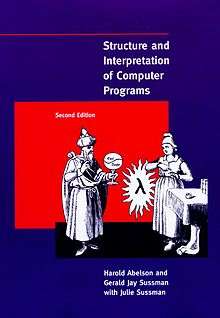Structure and Interpretation of Computer Programs
 Cover of the second edition | |
| Author | Harold Abelson, Gerald Jay Sussman, Julie Sussman |
|---|---|
| Subject | Computer programming |
| Genre | Textbook |
| Publisher | MIT Press |
Publication date | 1985 (1st ed.), 1996 (2nd ed.) |
| Pages | 657 |
| ISBN | 0-262-51087-1 (2nd ed.) |
| LC Class | QA76.6 .A255 1996 |
Structure and Interpretation of Computer Programs (SICP) is a textbook aiming to teach the principles of computer programming, such as abstraction in programming, metalinguistic abstraction, recursion, interpreters, and modular programming. It is widely considered a classic text in computer science,[1] and is colloquially known as the wizard book, due to the wizard on the jacket.[2] It was first published in 1985 by MIT Press and written by Massachusetts Institute of Technology (MIT) professors Harold Abelson and Gerald Jay Sussman, with Julie Sussman. It was formerly used as the textbook of MIT introductory programming class and at other schools. Before SICP, the introductory courses were almost always filled with learning the details of some programming language, while SICP focuses on finding general patterns from specific problems and building software tools that embody each pattern.[3]
Content
Using Scheme, a dialect of the Lisp programming language, the book explains core computer science concepts.
The program also introduces a practical implementation of the register machine concept, defining and developing an assembler for such a construct, which is used as a virtual machine for the implementation of interpreters and compilers in the book, and as a testbed for illustrating the implementation and effect of modifications to the evaluation mechanism. Working Scheme systems based on the design described in this book are quite common student projects.
Characters
The book uses some fictional characters repeatedly:
- Ben Bitdiddle. He considerably predates this class, having been created by Steve Ward for use in problem sets for its predecessor, 6.031, in the 1970s. He has since appeared in a large number of other locations, including other classes at MIT and other institutions.
- Eva Lu Ator: the evaluator
- Louis Reasoner: the loose reasoner
- Alyssa P. Hacker: a Lisp hacker
- Cy D. Fect: A "reformed C programmer."
- Lem E. Tweakit: an irate user of Alyssa's interval arithmetic, enters p. 96.
License
The book is licensed under a Creative Commons Attribution ShareAlike 4.0 License.[4]
Coursework
The book was used as the textbook of MIT's old introductory programming class, 6.001.[5] This class has been replaced by 6.0001,[6] which uses Python.[7] Other schools also made use of the book as a course textbook.[8] The second edition (ISBN 0-262-51087-1) appeared in 1996. More recently it is used as the textbook of MIT's Large Scale Symbolic Systems class, 6.945.[9]
Reception
Byte recommended SICP "for professional programmers who are really interested in their profession". The magazine stated that the book was not easy to read, but that it would expose experienced programmers to both old and new topics.[10]
Influence
SICP has been influential in computer science education, and a number of later books have been inspired by its style.
- Structure and Interpretation of Classical Mechanics (SICM), another book by Gerald Jay Sussman that uses Scheme
- How to Design Programs (HtDP), which intends to be a more accessible book for introductory Computer Science, and to address perceived incongruities in SICP
- Essentials of Programming Languages (EoPL), a book for Programming Languages courses
- Lisp in Small Pieces (LiSP), a book full of Scheme interpreters and compilers
References
- ↑ "The Top 9 1⁄2 Books in a Hacker's Bookshelf", Grok code, retrieved 2010-10-23
- ↑ "Wizard Book", The New Hacker's Dictionary (2nd ed.), 1993.
- ↑ Harvey, B (2011), "Why SICP matters?", The 150th anniversary of MIT, Boston Globe.
- ↑ SICP, MIT press.
- ↑ "Electrical Engineering and Computer Science | 6.001 Structure and Interpretation of Computer Programs". OpenCourseWare. MIT. Spring 2005. Retrieved 2011-06-28.
- ↑ "6.0001", Catalog, MIT.
- ↑ Guy, Donald, "The End of an Era", MIT Admissions (blog comment), retrieved 2008-08-05,
I talked to Professor Sussman on the phone... He said that he'd actually been trying to have 6.001 replaced for the last ten years (and I read somewhere that Professor Abelson was behind the move too). Understanding the principles is not essential for an introduction to the subject matter anymore. He sees 6.001 as obsolete
. - ↑ Martin, Edward C (2009-07-20). "Schools". Schemers. Retrieved 2011-06-28.
- ↑ http://eduapps.mit.edu/textbook/books.html?Term=2016SP&Subject=6.945
- ↑ Kilov, Haim (November 1986). "Structure and Interpretation of Computer Programs". Byte. p. 70.
Further reading
- A critique of Abelson and Sussman or Why calculating is better than scheming (PDF), UK: Kent.
- The Structure and Interpretation of the Computer Science Curriculum (PDF), Brown, a critical view of SICP and rationale for How to Design Programs
External links
- "SICP", MIT Press (official site), MIT Press (including the full text in HTML).
- Abelson; Sussman (July 1986), SICP Lectures (videos), MIT.
- "6.001", SICP (official site), MIT, Spring 2007 (an MIT course that goes by the same name as the book).
- Open Courseware - SICP, MIT, Spring 2005.
- SICP, MIT AI Laboratory, Technical Report 735, draft 1983-07-31